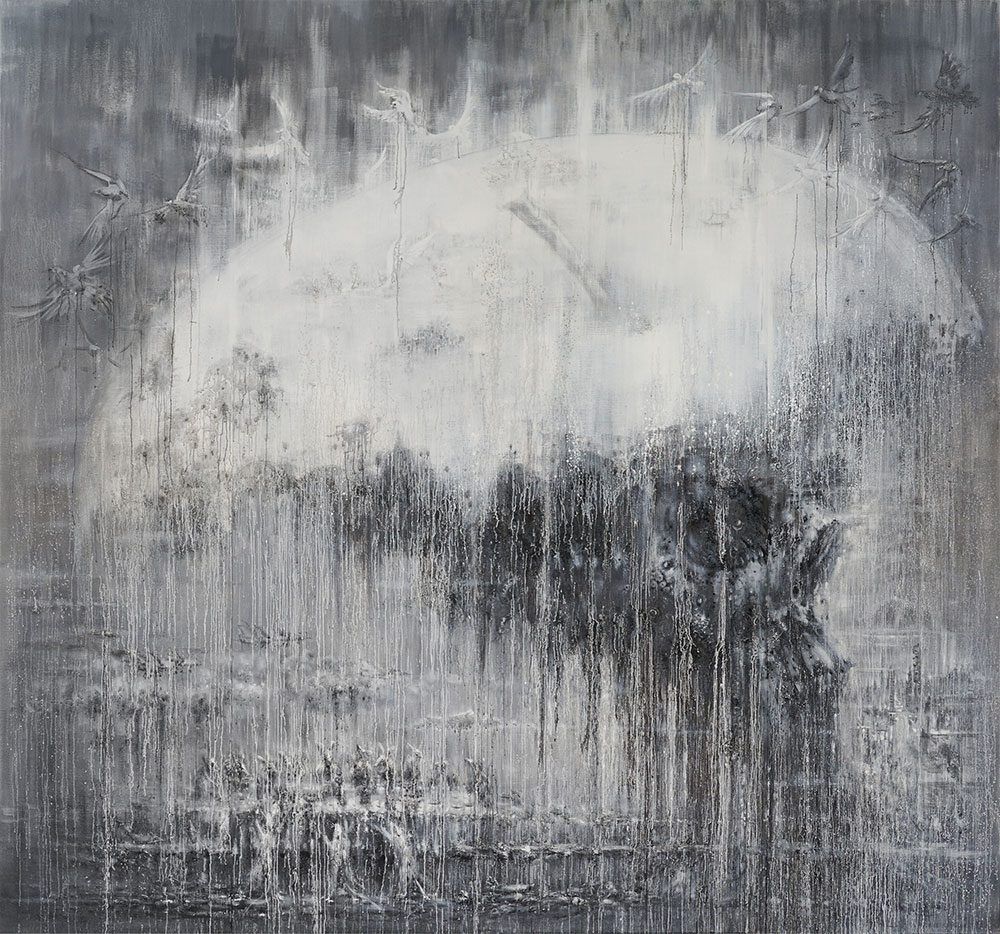孟岩的绘画,当代之中古意氤氲。所谓“古意”,我并非指其“老式”。相反,他的创作超越任何“式”,试图寻找一种不论在当代、还是过去或未来都隽永而本真的东西。要捕捉到这种飘忽的特质绝非易事;当然,也非所有画家都能企及。
本次展出的作品分为三大系列,特色鲜明,又交相辉映。宏大主题、巨幅尺寸,画作的分量感冲击着我们的视觉感受和智觉感受。换言之,这些绝不是“轻松的”作品。而这种气场让观者有时难以进入作品。孟岩的每一幅绘画都堪称一部创作史:颜料的材质感、厚重感和纹理感直白袒露,画布上层层涂刷和刮擦的痕迹历历可见。
孟岩的作品非亲见不能感受;隔着屏幕、甚至通过画册都难以呈现其面貌。因为,作品是有生命的,需要直面另一个生命体。惯性意味着画家和绘画的消亡。
在这篇短文中,我希望能开启关于如何更好地直面这些画作的对话。问题需要提出。当然,我无法保证给出任何答案。孟岩亦不能。问本身便是意义所在。好的艺术要求我们提出问题。正因如此,好的艺术才有意义。
绘画的艺术亦是直面的艺术。对此,孟岩的理解可谓透彻。
肖像画往往占据着室内最显著的位置。其所表现的人物多已作古,这就要求我们直面终将来临的死亡。在这个意义上,它们所表现的其实是芸芸众生相。如果真有孟岩所谓“刮骨”之法能够深入画中人物脑海内一窥,我会建议大家也去刮开他的、以及我们自己的现实之“骨”。阿尔伯特·爱因斯坦、温斯顿·丘吉尔、弗朗西斯·培根、萨尔瓦多·达利、安迪·沃霍尔、玛丽莲·梦露如何与我们的世界观融为一体?这其中没有单一的、一目了然的因果叙述,每个人对我们的社会文化场域都有着不可磨灭的影响。他们是无尽历史矩阵中的一个个组成部分。我们无不如此。
所谓史诗更像是一头狡黠的野兽。绘画亦然,但却有着持久留存的特点。
在《危机》系列中,孟岩将关注的目光投向超越个体之上的普世视角,在历史与梦想之间上下求索,描绘出属于这个时代的肖像。在他所有的作品中,不论在内容、尺幅还是体力消耗的维度上,这一系列都可谓最为宏大;过去十余年中他持续投入在《危机》系列的创作和精进中。多面庞然巨物承载着象征、历史、焦灼,当然,也饱蘸颜料;德语中赋予这种体验一个专有名词—“狂飙突进”(Sturm und Drang);趋近黑暗浪漫主义,以主观性和极端情绪作为对社会理性规范的回应,或曰解药。
孟岩的作品中虽有宗教元素,但我们不应进而将他和他的作品归为“宗教画家”或“宗教绘画”。相反,如20世纪现代主义艺术家柯林·麦卡宏(Colin McCahon)所言,宗教人物和叙事变成了一种速写法,一种精神能指的集合,但从来不是作为某种容易的答案出现。
在《最后的晚餐》(2008-2016)中,(显然取材自列奥纳多·达·芬奇名作),置身于上空的耶稣和他的门徒们头顶着光环,身无实形、体无实质,头部和躯干部位颜料滴落,犹如鲜血流淌在尘世灾难图景之上。他们似乎在哭泣。或者,这是否在暗示无论是灵界还是尘世,面对人类对世界的摧残与破坏,没有任何一方能自居无辜?
某种程度上,《苹果核》(2014-2018)在《危机》复杂的叙事和充满象征意味的幻景、以及《活着》(2017-2018)的高度抽象之间搭起一座桥梁。在这幅作品中,伊甸园中象征基督教原罪的禁果,与爱因斯坦因对科学的盲目信仰而招致的原子弹蘑菇云梦魇结合在一起。能量的爆发、肌理的断层,既是《雄心》、《欲望》、《危机之源》、《最后的晚餐》(均为2008-2016 的创作)中的反乌托邦的构成,也是其最终的归宿。尽管如此,我并不认为孟岩是位悲观主义者。极致的黑暗中孕育着巨大的光明。如果说《危机》(又名《危机之源》系列)是为社会可能发生的自我毁灭和贪痴所立的纪念碑,那么,作为其对立面的奇迹和超验也必须存在。
孟岩的思想始终存在着某种互文性,能够在东西两种模式间轻松转换,并让人更多地感受到一种流动感,而非二元对立性。这是一场有无限切入点的双重游戏。对于西方观众来说,罗兰·巴特把“作者已死”和互文阅读等批判思考引入公众意识领域,让读者/观者位于作品中心,而非处在叙事/绘画之外。然而在中国诗画中,活跃的读者/观者(activated reader/viewer) 这一概念本身就已经蕴含在作品之中,“游走式”的欣赏方式是水到渠成的,其在绘画中常表现为三段式构图,而在诗歌中则借助立体感极强的书法字体来实现。再加上古典诗歌的开放式句法,共同缔造了卧游这一美学概念。从构图和空间上来说,郭熙(1020-1090)的《早春图》、董源(934-962)的《秋山问道图》等经典名作之于《危机》中浮躁动荡图景的影响,就如同超现实主义之于萨尔瓦多·达利。
作为一名西方作者,很容易陷入对中国绘画空间沉浸式表现的视而不见,而只对作品进行好与坏、天与地等简单的二元解读。只有对禅宗的因果轮回、易学、老庄思想有所了解,我们才能真正形成“大局观”。每一处细节都令人着迷,每一个象征式人物背后都有一段故事;(不论透视还是观念上)画面并非遵循单一视角,沉浸于某种空无的丰盈,把自己完全交给这些鸿篇巨制所营造的充沛的深邃感,“万物皆在其中,却空如无物”,这不是更令人振奋吗?
《活着》系列正是脱胎于这份深邃的内外。如果说《肖像》和《危机》系列体现了将过去和当下作为一个连续的整体来挖掘和呈现,那么《活着》则完全着眼于未来。以超越画面之外的空间作为一切的源泉,孟岩很大程度上回避了过去数十载实践中所形成的表现语言,将内在的错综与复杂掩映于外在的简单之下。孟岩以油彩为媒,将传统水墨的灵动、书法线条的优美、静气凝精与恣意挥洒、高亮的色调与晦暗的黑白融为一体,让画面在碰撞中交融。传统的图像/背景关系消融于画面之中,幻化为纯色、光影、能量和物质。
尽管作品洋溢着强烈的气运感,但如果我们从美国抽象表现主义的角度来解读他的作品,这无疑是错误的。孟岩的作品也不同于西方非写实类的抽象——即仅仅将绘画作为关系场域中的形式对象。我倾向于将其与二战后崛起的新巴黎画派和不定形艺术联系起来。法国艺术家皮埃尔·苏拉热(Pierre Soulages)、乔治·马修(Georges Mathieu)等人将集体乌托邦精神与抒情抽象和新实体主义相结合,随后,赵无极、朱德群等一大批华裔艺术家加入他们的行列,体现了早期移居海外的华人艺术家尝试与西方绘画展开对话。孟岩的新作中有一些普世的元素可以视作向这批先驱艺术家的致敬。不过在抒情性之外,孟岩的创作手法中洋溢着一股迫切感和愤怒感,反差强烈的色调选择在勾勒当下的同时,也揭示出某些尚未为人所见的东西。我把这些作品统称为抽象,但事实上如此归类似乎并不精确。孟岩为上述对话加入了新的内容;形式的痕迹、生命的讯息、成形乃至无形的人物纷纷在视网膜上飘忽而过。
放弃形式不等于忘记形式。在孟岩的世界里,我们看到一切皆有可能。
回到本次展览的空间——嘉善博物馆。孟岩别具匠心地把展厅分割为一个个“空间单元”。这本画册亦然。闲庭信步之间,观者的感受与漫步于古典庭院又截然不同。观众可以自行选择赏画路径,进退由心;我们会发现自己徜徉于思想的河流之中,所感远超所见。
不同作品系列之间的区别是明显的:《肖像》的栩栩如生,《危机》的宏篇巨幅和沉浸式的叙事氛围,《活着》中极富爆发力的抒情唯物主义——孟岩似乎完全投身于对抽象的求索之中。
写到这里,我想你已经明白在孟岩和他的艺术中,没有田园牧歌,也没有流行的装饰元素。
孟岩的创作频谱是激进的。作为观众,你也“被迫”要去直面、并最终拥抱这样一种激进的观看、欣赏和行动方式。空白画布从不只是空白画布。
这位艺术家从不只是一位画家。
新西兰/澳大利亚视觉艺术家和作家 克雷格·伊斯顿

苹果核 Apple Core 430x400cm 2014-2018
Confronting Meng Yan
For all of his contemporaneity there is something ancient in the way Meng Yan approaches his painting practice. In using the word ‘ancient’ I don’t mean to say ‘old fashioned’. On the contrary it is to be without fashion, to search for something timeless and authentic to this present moment and all other moments, past and future. The capturing of such elusive things is not easy, and certainly not the preserve of just any painter.
There are essentially three bodies of paintings in this carefully curated exhibition. They are distinct and yet entwined. These paintings in all their weight, scale and subject matter are frequently confronting to our visual sensibilities and our intellects. They are not ‘easy’ paintings. We do not so much absorb them as wrestle with their difficulties. A painting by Meng Yan wears its history of making: unashamed materiality, heaviness and texture of paint, the alternately caressing and attacking brush and scrapings of its strata.
These are paintings to be seen in the flesh, not on a screen, nor even in this book you are holding. That's because a painting is alive and needs to be confronted by another living being. Inertia is the death of painters and painting.
With this short essay I hope simply to start a conversation around how best to confront such paintings. Questions need to be asked. Yet I can’t promise any answers. And neither can Meng Yan. It’s the asking that matters. Good art asks that we ask. And for this reason good art matters.
The art of painting is also the art of confrontation. Meng Yan understands this better than most.
Portraits have a habit of dominating a room. In their raw state, and mostly of figures past, they require we confront our own mortality. They are after all drawn in our own image. If there is what Meng Yan calls a “scraping of the bones” to get inside the heads of those portrayed, I suggest we are also scraping the bones of his, and our own, realities. How do Albert Einstein, Winston Churchill, Francis Bacon, Salvador Dalí, Andy Warhol and Marilyn Monroe fit into our own worldview? There is no singular, immediately discernible narrative of cause-and-effect to be drawn, but for each person’s undeniable effect on our socio-cultural realms. They are pieces of an endless matrix of history. As are we all.
Historical fact is a slippery beast. Paint can be slippery too but has the advantage of staying where you stick it.
For the Crisis series Meng Yan moves definitively beyond the individual to the universal, scanning the horizon he reaches into history and his dreams, to render portraits of our times. Of all his endeavours this one is the grandest in content, scale and pure physical labour, producing and refining the Crisis paintings over the period of a decade. Great hulking multi-faceted things overloaded with the sheer weight of symbolism, history, personal angst and, of course, paint, they carry that thing the Germans speak of as “Sturm und Drang”; tending to a dark Romanticism with subjectivity and extreme emotions played out as reaction or antidote to society’s rationalist norms.
Where religion appears in Meng Yan’s work we needn’t read it as marking these works out as ‘religious paintings’ or Meng Yan as a ‘religious artist’. Instead, as with the twentieth century modernist Colin McCahon, religion with its associated figures and narratives becomes a kind of shorthand, a collection of signifiers of the spiritual, but certainly never presented as easy answer.
In The Last Supper (2008 - 2016), a clear reference to the famous Leonardo Da Vinci painting of the same name, Jesus and his Apostles are haloed figures floating disembodied, or disemboweled (?), head and torsos with paint dripping like so much blood upon the scenes of earthly destruction depicted below. Weeping they may be. Or could it be to suggest no power, spiritual or earthly, remains innocent of the devastation wreaked by man upon this world?
With Apple Core (2014 - 2018) I think we can discern something of a bridge between the complex narrative and symbol heavy dreamscapes of Crisis and the abstraction of the Alive works (2017 - 2018). In this one image we have the forbidden fruit of Christianity’s original sin in the Garden of Eden combining with the sin of the atomic mushroom cloud as the bad dream of Einstein’s blind faith to science. This burst of energy, this rupture in the fabric completing and answering the dystopias of The Ambition, The Lust, The Source of Crisis and The Last Supper (all 2008 – 2016). And yet, and yet…I do not choose to read Meng Yan as the great pessimist. Where there is great darkness there is also great light. If the Crisis works (also known as the Monumental series) are monuments to society’s potential for self-destruction, greed and stupidity, their opposites in the possibility of wonder and transcendence must also exist.
There is a constant inter-textual game at play in Meng Yan’s thinking that includes an easy slippage between Eastern and Western modes, illustrative less of binaries and more of fluidity.
This is a double game with endless points of entry. For Western audiences Roland Barthes may have helped bring to public consciousness critical ideas around ‘the death of the author’ and inter-textual reading, whereby the reader/viewer rather than external to the narrative/painting is placed centrally ‘in’ the work. But in both Chinese painting and poetry the notion of an activated reader/viewer located within the work and thus encouraged to take a wandering view is a natural one, expressed through techniques including the three-distance method and in poetry the almost three-dimensional aspect of the calligraphic character. This, alongside the open syntax of classical poetry, contributes to this idea of the wandering mind and spirit. Compositionally and spatially a painting like Spring Morning by Guo Xi (1020 - 1090) or Taoist Temple in the Mountains by Dong Yuan (934 - 962), in all its beauty, is arguably as essential to the troubled floating realms of the Crisis paintings as anything from the Surrealism of Salvador Dalí.
As a Western writer it is all too easy to gloss over the immersive intent of the Chinese approach to painted space, and equally to read these paintings as a simplified two-term analysis between good and evil or heaven and earth. Instead it makes sense to also draw upon the karmic cycles of Chan Buddhism, and the forever changing Tao and teachings of Laozi, so that we are indeed dealing with the whole of the undifferentiated Fount . Each detail fascinates the eye, each symbolic figure offers a possible story, but instead of following the single perspective (optically or conceptually) is it not more exciting to give ourselves over to the empty fullness, the ‘everything and nothing’ of these vast paintings as both surface and bottomless depth?
It is from within and out of this depth that Meng Yan’s Alive paintings emerge. Where the Portraits and Crisis series have in part been an attempt at mining and representing both history and the present as contiguous states, Alive has its sights firmly on the future. Recognising the space beyond the image as the Fount from which all else appears, Meng Yan largely sidesteps the powerful representational languages developed over decades of practice to pull astounding complexity from apparent simplicity. Still working in oils he fuses the fluidity of traditional ink, the beauty of the calligraphic line, directional and chance gestures, use of high-key pigments and monochrome palettes, developing both scaffold and dissolution on/in/out of the one surface. Normative figure ground relationships dissolve into paintings remade as pure colour, light, energy and matter.
Whilst heavily imprinted with the gestural, it would be misleading to fixate on the heroic individualism of American Abstract Expressionism in considering these paintings. Neither is it in the abstraction of the Western Non-objective model – an art focusing on the painting simply as a formal object in its own field of relations. Instead I would look to the post-Second World War rise of the New School of Paris and Art Informel. Marrying a collective utopian spirit with new combinations of Lyrical Abstraction and Neo Concretism, French artists Pierre Soulages and Georges Mathieu were joined by a wide array of international artists including Zhao Wuji and Zhu Dequn, representing Chinese modernism’s early émigré forays into Western painting dialogues. There is something in the universalism of Meng Yan’s new works that pays an elegant debt to these men. But where those artists’ lyricism prevailed, there is an urgency and fury to Meng Yan’s method, and a wildly contrasting, sometimes electrified colour palette that manages to be both of our contemporary moment and still offer something as yet unseen. I have written of these works as being abstract, but in truth it is an uneasy alliance. Meng Yan brilliantly contributes to the discourse; while all the time hints of form, signs of life, figures in the act of becoming and unbecoming flit across the retina.
Letting go of form is not the same as forgetting form. In Meng Yan’s universe we learn everything is possible.
Returning to this space, here/now, in Jiashan Museum, Meng Yan has opted for a careful dividing up of the gallery into a series of ‘space cells’. This catalogue does something similar. And so you are free to meander contained/uncontained in a way not so unlike a stroll in an ancient literati garden. Able to choose our own path through the paintings, to push ahead or to double back, we find ourselves swimming in a flow of ideas that I hope by now you accept reaches well beyond the visual.
There are clear differences in the bodies of work: the remarkable verisimilitudes of the Portraits, the monumentalism of scale and immersive story telling of Crisis, and the explosive lyrical materialism of the Alive series - in which Meng Yan seemingly gives himself over to the abstract impulse.
I expect by now you will have realised when you choose to follow Meng Yan and his art there is no chance of a polite invitation into an idyllic landscape, or even an offer of fashionable decoration.
Meng Yan embraces a radical spectrum of making. And you in turn as viewer are ‘made’ to confront, and ultimately embrace, a radical way of looking, seeing and doing. The blank canvas is never just a blank canvas.
The artist is never just a painter.
Craig Easton






 皖公网安备 34010402700602号
皖公网安备 34010402700602号